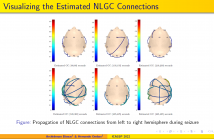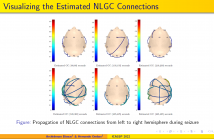
- Read more about Ensemble and Personalized Transformer Models for Subject Identification and Relapse Detection in E-Prevention Challenge
- Log in to post comments
In this short paper, we present the devised solutions for the subject identification and relapse detection tasks, which are part of the e-Prevention Challenge hosted at the ICASSP 2023 conference [1] [2] [3]. We specifically design an ensemble scheme of six models - five transformer-based ones and a CNN model - for the identification of subjects from wearable devices, while a personalized - one for each subject - scheme is used for relapse detection in psychotic disorder.
- Categories:
 19 Views
19 Views
- Read more about Cross-site Generalization for imbalanced epileptic classification
- Log in to post comments
Recently, many studies have been conducted on automated epileptic seizures detection. However, few of these techniques are applied in clinical settings for several reasons. One of them is the imbalanced nature of the seizure detection task. Additionally, the current detection techniques do not really generalize to other patient populations. To address these issues, we present in this paper a hybrid CNN-LSTM model robust to cross-site variability. We investigate the use of data augmentation (DA) methods as an efficient tool to solve imbalanced training problems.
- Categories:
 14 Views
14 Views
- Read more about Cross-site Generalization for imbalanced epileptic classification
- Log in to post comments
Recently, many studies have been conducted on automated epileptic seizures detection. However, few of these techniques are applied in clinical settings for several reasons. One of them is the imbalanced nature of the seizure detection task. Additionally, the current detection techniques do not really generalize to other patient populations. To address these issues, we present in this paper a hybrid CNN-LSTM model robust to cross-site variability. We investigate the use of data augmentation (DA) methods as an efficient tool to solve imbalanced training problems.
- Categories:
 9 Views
9 Views
- Read more about Cross-site Generalization for imbalanced epileptic classification
- Log in to post comments
Recently, many studies have been conducted on automated epileptic seizures detection. However, few of these techniques are applied in clinical settings for several reasons. One of them is the imbalanced nature of the seizure detection task. Additionally, the current detection techniques do not really generalize to other patient populations. To address these issues, we present in this paper a hybrid CNN-LSTM model robust to cross-site variability. We investigate the use of data augmentation (DA) methods as an efficient tool to solve imbalanced training problems.
- Categories:
 6 Views
6 Views
- Read more about SEGNET-BASED DEEP REPRESENTATION LEARNING FOR DYSPHAGIA CLASSIFICATION
- Log in to post comments
- Categories:
 85 Views
85 Views
- Read more about Joint Model Order Estimation for Multiple Tensors with A Coupled Mode and Applications to the Joint Decomposition of EEG, MEG Magnetometer, and Gradiometer Tensors
- Log in to post comments
The efficient estimation of an approximate model order is essential for applications with multidimensional data if the observed low-rank data is corrupted by additive noise. Certain signal processing applications such as biomedical studies, where the data are collected simultaneously through heterogeneous sensors, share some common features, i.e., coupled factors among multiple tensors. The exploitation of this coupling can lead to a better model order estimation, especially in case of low SNRs.
- Categories:
 15 Views
15 Views
- Read more about Parametric Modeling of Human Wrist for Bioimpedance-based Physiological Sensing
- Log in to post comments
Bioimpedance is a powerful modality to continuously and non-invasively monitor cardiovascular and respiratory health parameters through the wearable operation. However, for bioimpedance sensors to be utilized in medical-grade settings, the reliability and robustness of the system should be improved. Previous studies provide limited fundamental analyses of the factors involved in the system that impact the sensitivity and the specificity of the modality in capturing the hemodynamics.
- Categories:
 16 Views
16 Views
